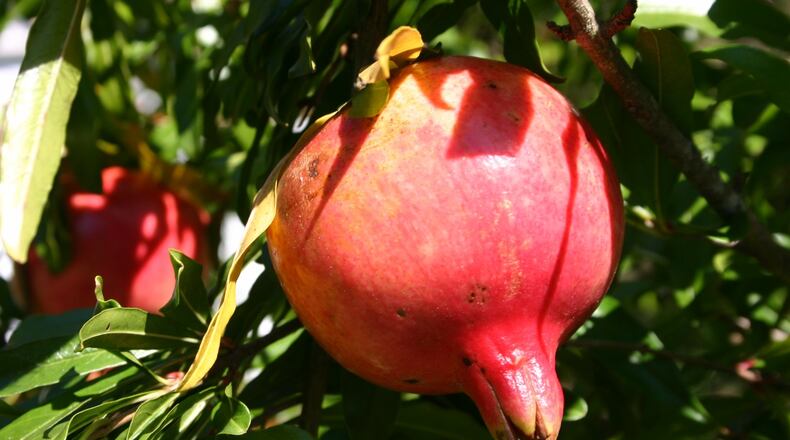Q: My wife and I have three 6-year-old pomegranate trees. One of them is full of orange flowers but only one or two fruits. Most of the flowers are single, but there are many double flowers, too.M.V. George, Johns Creek
A: I think poor pollination is the root problem of poor fruiting. Double-flowered pomegranates usually have small fruit or none at all because it is too hard for insects to get inside the petals and move the pollen around. Single-flowered types are pollinated by bees, but if you are not getting fruit, that tells me you don't have enough bees working the flowers.
It is easy to pollinate flowers by hand. Get a small artist’s paintbrush and gently probe inside a flower until the tip is covered in yellow pollen. Move to another flower and do the same. Do this once a day as new flowers open. You can stop when there are no new flowers. You should see round pomegranate fruit forming where the flowers fall off. If you enjoy eating pomegranates, look online for Russian varieties. They are more cold-hardy than the common ‘Wonderful’ cultivar.
Q: I just dug up my daffodils to separate them. Do you recommend replanting them now, or wait until the fall?Alan Cyrier, email
A: Replant them now. There will be minor root growth during the summer, but that's better than being stored in your garage. As long as they are replanted in a spot that does not stay soggy, they will produce foliage in early winter and bloom properly next year.
Q: Some areas of my lawn look really stressed from drought. I try to water it once a week for 20 minutes each zone.Debbie Hipps, McDonough
A: You need to know how much water is being applied in 20 minutes. Set six identical plastic cups in an irrigated zone and let it run for 20 minutes. Look in your cups and see how much water has accumulated. Use your elementary math skills to figure out how long it would take to accumulate an inch. In the heat of summer, when your lawn grass looks dried out, schedule 1 inch of water to be applied once per week in the absence of rain. The best time to water a lawn is in the morning, before the sun heats up the soil.
Q: Will locust trees do well here? They are so amazingly fragrant when their white flowers come out in the late spring.Bart Daugherty, Sugar Hill
A: Black locust, Robinia pseudoacacia, and honey locust, Gleditsia triacanthos, are commonly grown in Georgia. Good sources of native plants include Trees Atlanta (treesatlanta.org), Chattahoochee Nature Center (chattnaturecenter.org), Nearly Native Nursery (nearlynativenursery.com), Night Song Native Plant Nursery (nightsongnatives.com), GSU Perimeter College Native Plant Garden (sites.gsu.edu/pcnativegarden) and the Georgia Native Plant Society (gnps.org).
Listen to Walter Reeves Saturday mornings on News 95.5 FM and AM750 WSB. Visit his website, www.walterreeves.com, follow him on Twitter @walterreeves, on Pinterest, or join his Facebook Fan Page at bit.ly/georgiagardener for more garden tips.
About the Author
Keep Reading
The Latest
Featured

